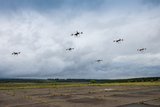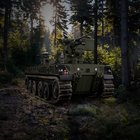Predator B ER completes Phase 1 flight testing
The Predator B Extended Range (ER) unmanned aerial vehicle (UAV) has completed its second successful long-endurance flight, bringing the system’s Phase 1 flight test period to an end.
The flight, which took place from 17-18 June, saw the Predator B ER demonstrate its ability to carry an external fuel tank on each wing, and used a new fuel management system which ensures fuel and thermal balance amongst all fuel sources, including the external tanks, the wing, and the fuselage.
The aircraft also demonstrated its Alcohol Water Injection (AWI) system, which shortens the required runway takeoff length, especially at higher gross takeoff weights, higher altitude take-offs, and on hot days; and improves climb out performance and fuel efficiency.
Frank W Pace, president, Aircraft Systems, General Atomics Aeronautical Systems, Inc, said: ‘This flight was a significant milestone for Predator B ER in that it closes out its Phase 1 flight test period. The entire [remotely piloted aircraft] system was successfully tested from start to finish, including flying a real-world representative mission with significant loiter time, and then returning to base.’
Introduced in 2012, GA-ASI is developing Predator B ER to extend Predator B's endurance and range greatly while also increasing its operational flexibility. The ER variant optimises the aircraft for intelligence, surveillance, and reconnaissance (ISR) missions with a projected increase in endurance from 27 to 33-35 hours by adding two external fuel tanks to its existing wings and heavy-weight landing gear to accommodate an increase in maximum gross takeoff weight.
GA-ASI is also funding an internal programme to develop an add-on ER option that optimises the aircraft for multi-purpose missions with a projected increase in endurance from 27 to 42 hours for ISR-only by replacing its current fuel-filled 66ft wings with 79ft wings. Completion of the first fuel-filled, longer wing is expected this summer, with the first test flight to follow before the end of the year.
More from Uncrewed Vehicles
-
![US Navy foresees an uncrewed future for its surface and underwater fleet]()
US Navy foresees an uncrewed future for its surface and underwater fleet
The service has been conducting various procurement and development efforts to integrate unmanned surface and underwater vehicles into its inventory.
-
![Ready for the race: Air separation drone swarms vs. air defence systems]()
Ready for the race: Air separation drone swarms vs. air defence systems
As the dynamics of aerial combat rapidly evolve, Chinese scientists have engineered a sophisticated air separation drone model that can fragment into up to six drones, each capable of executing distinct battlefield roles and challenging the efficacy of current anti-drone defences such as the UK’s Dragonfire laser system.
-
![Israel’s MALE UAVs ‘must adapt’ to Iranian-made air defences]()
Israel’s MALE UAVs ‘must adapt’ to Iranian-made air defences
Advancements in air defence technologies have begun to reshape aerial combat dynamics in the Middle East, as illustrated by recent events involving the Israeli Air Force and Hezbollah.
-
![Hundreds more UAS sent to Ukraine forces with thousands more on the way]()
Hundreds more UAS sent to Ukraine forces with thousands more on the way
Both sides of the Russia-Ukraine war have been using UAS for effective low-cost attacks, as well as impactful web and social media footage. Thousands more have now been committed to Ukrainian forces.
-
![AI and software companies selected for US Army Robotic Combat Vehicle subsystems]()
AI and software companies selected for US Army Robotic Combat Vehicle subsystems
The US Army has intentions to develop light, medium and heavy variants of the Robotic Combat Vehicle (RCV) as part of the branche’s Next Generation Combat Vehicle family.

























